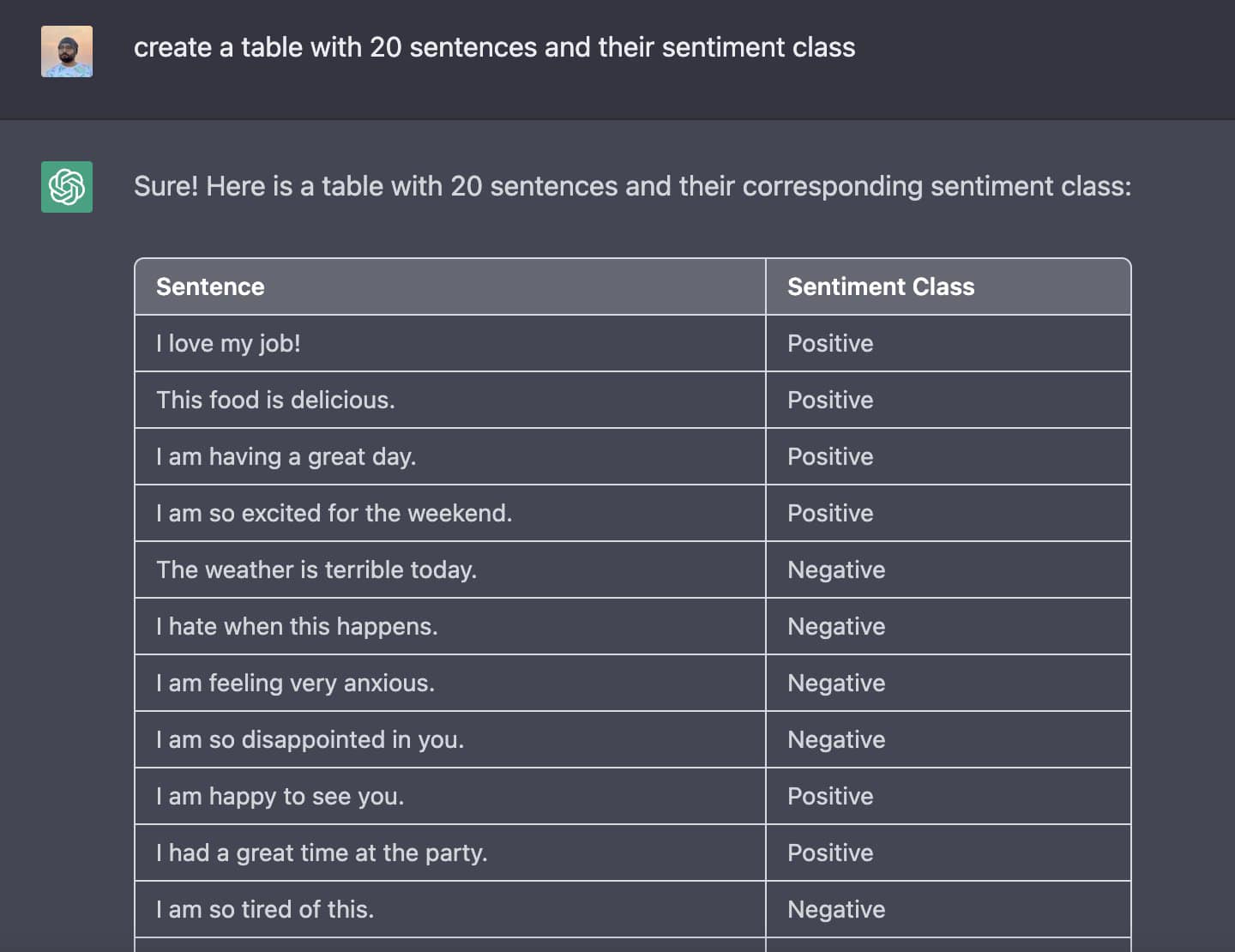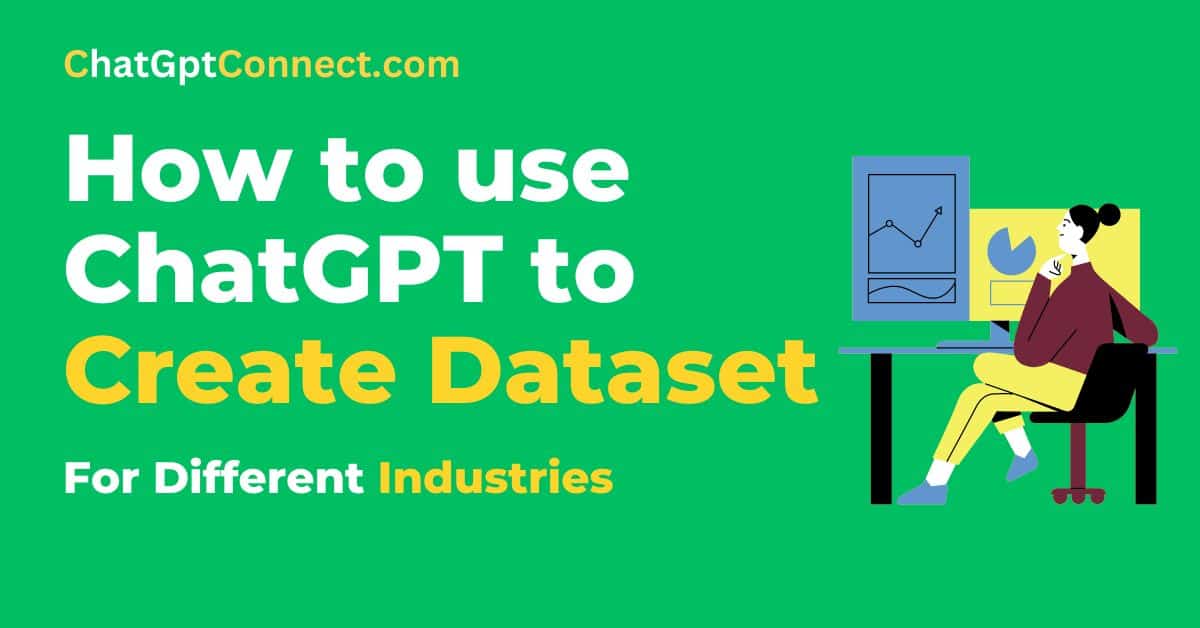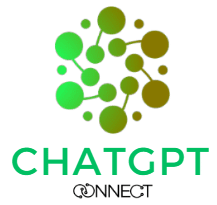Are you looking for a faster and more efficient way to create high-quality datasets? Look no further than ChatGPT. You can use ChatGPT to create dataset. With its advanced language generation capabilities, ChatGPT can be used to create datasets in a variety of fields, from healthcare to finance to marketing. Using ChatGPT to create datasets has numerous benefits, including cost-effectiveness and customization to specific needs. In this article, we will explore how to use ChatGPT to create a dataset and share best practices for ensuring its quality and accuracy.
Creating a dataset can be a time-consuming and tedious process, often requiring manual data collection and cleaning. This can result in a limited and potentially biased dataset, which can impact the accuracy and effectiveness of machine learning models. However, you can use ChatGPT to create dataset, you can generate high-quality and diverse data quickly and efficiently.
Readers can expect to learn how to use ChatGPT to create dataset that is tailored to their specific needs, and the benefits of doing so. By using ChatGPT to generate text data, readers can save time and resources while also obtaining a more diverse and accurate dataset, leading to better machine learning models.
What a dataset is and why it’s important:
In the world of machine learning and AI, datasets play a crucial role in the development and training of models. A dataset is a collection of data points that are used to train and test machine learning models. You can train data using Hugging Face. It can include various types of data, such as text, images, and numerical values.

Types of Datasets:
There are several types of datasets, including:
- Training datasets: used to train machine learning models
- Validation datasets: used to validate the accuracy and effectiveness of trained models
- Test datasets: used to test the performance of trained models on new data
- Public datasets: publicly available datasets that can be used for research or educational purposes
- Private datasets: proprietary datasets that are not publicly available
Importance of High-Quality Datasets:
Creating high-quality datasets is essential for developing accurate and effective machine learning models. A high-quality dataset should be diverse, representative of the population it is intended to represent, and free from bias or errors. Inaccurate or biased datasets can lead to flawed models that make incorrect predictions or decisions.
ChatGPT is an advanced language generation model that can be used to create high-quality datasets quickly and efficiently.By understanding the different types of datasets and the importance of creating high-quality data, users can make informed decisions when creating and selecting datasets. Using ChatGPT to generate text data is a powerful tool for creating high-quality datasets quickly and efficiently.
Benefits of Using ChatGPT to Create a Dataset:
using ChatGPT to create a dataset is a powerful tool for improving the quality of your data and ultimately building better machine learning models. By providing customization, cost-effectiveness, diverse data, and accuracy, ChatGPT has become a go-to option for data scientists and researchers alike. So if you’re looking to create high-quality datasets quickly and efficiently, look no further than ChatGPT.
- Customization: One of the most significant benefits of using ChatGPT to create a dataset is the ability to customize it to your specific needs. ChatGPT allows you to generate text data based on specific prompts or topics, ensuring that your dataset is tailored to your needs.
- Cost-Effectiveness: Creating a dataset manually can be time-consuming and costly, requiring a significant amount of resources to collect, clean, and organize data. By using ChatGPT, users can generate high-quality data quickly and efficiently, saving time and resources in the process.
- Diverse Data: Another major benefit of using ChatGPT to create a dataset is the ability to generate diverse and accurate data. ChatGPT can generate text data in various formats, including long-form articles, product descriptions, and even chatbot conversations. This diversity allows for more comprehensive and representative datasets, leading to better machine learning models.
- Accuracy: ChatGPT is an advanced language model that has been trained on massive amounts of data, making it highly accurate at generating text. This accuracy translates to the generated data, resulting in a more accurate and reliable dataset for training and testing machine learning models.
You can use ChatGPT Detector to check either content is written by ChatGPT or not.
How to Use ChatGPT to Create a Dataset:
Step 1: Define Your Dataset
Before you start generating text, you need to define the purpose and scope of your dataset. What kind of data are you looking to collect? What are the key features or attributes that you want to capture? What is the size and format of your dataset? Answering these questions will help you create a clear and structured plan for your data collection.
Example: Let’s say you want to create a dataset of movie reviews for sentiment analysis. Your dataset will consist of text snippets (e.g., sentences or paragraphs) that express the sentiment of the writer towards a particular movie. You want to capture the overall sentiment of the review (positive, negative, or neutral) as well as some context information, such as the title and release year of the movie.
Step 2: Choose Your Prompts
Now that you have a clear idea of what kind of data you want to collect, it’s time to choose your prompts. A prompt is a sentence or phrase that you give to ChatGPT to generate text. The quality and relevance of your prompts will have a significant impact on the quality of your dataset. Here are few prompts that you can use to generate your desired dataset
Examples : Use ChatGPT to Create Conversation Datasets
ChatGPT is a large language model that can be used to generate conversational text. It can be a valuable resource for creating conversation datasets for machine learning and natural language processing applications. Here are some prompts to get started:
- Can you give me some conversation examples of a discussion between two people?
Example:
Person 1: Hi, how are you doing?
Person 2: I’m doing pretty well, thanks for asking. How about you?
Person 1: I’m doing okay. So, did you hear about the new restaurant that just opened up?
Person 2: No, I didn’t. What’s it called?
- Can you give me some conversation examples between two people who are fighting?
Example:
Person 1: I can’t believe you did that! How could you be so selfish?
Person 2: What are you talking about? I didn’t do anything wrong.
Person 1: You know exactly what I’m talking about. You went behind my back and did something that directly impacted me.
Person 2: I didn’t mean to hurt you. I just thought it was the best decision at the time.
- Can you give me 20 conversation examples where one person is angry and the other person is trying to help the angry person?
Example:
Person 1: I can’t believe this happened! I’m so angry right now!
Person 2: I understand that you’re upset, but let’s try to take a deep breath and calm down.
Person 1: How can I calm down? This is outrageous!
Person 2: I know it’s frustrating, but getting angry won’t solve the problem. Let’s talk about what we can do to fix this.
- Can you give me some conversation examples of two people discussing their favorite hobbies?
Example:
Person 1: So, what do you like to do in your free time?
Person 2: I’m really into gardening. I find it really relaxing and rewarding.
Person 1: Oh, that’s interesting. I’ve always been interested in photography myself.
Person 2: That’s cool. What kind of photography do you like to do?
- Can you give me some conversation examples between two people discussing a recent movie they saw?
Example:
Person 1: Hey, have you seen that new movie that just came out?
Person 2: Yeah, I saw it last weekend. It was pretty good.
Person 1: Really? I heard mixed reviews about it.
Person 2: I think it’s definitely worth seeing. The acting was really impressive.
- Can you give me some conversation examples of two people planning a surprise party?
Example:
Person 1: Okay, so here’s the plan. We’ll invite everyone over to your house on Friday night, and then we’ll jump out and surprise them.
Person 2: That sounds like a lot of fun. Do you have any ideas for decorations or food?
Person 1: I was thinking we could get some balloons and streamers, and I’ll make my famous chili.
- Can you give me some conversation examples between two people discussing their favorite travel destinations?
Example:
Person 1: I’ve always wanted to visit Japan. Have you ever been there?
Person 2: Yes, I actually went there last year. It was amazing.
Person 1: Really? What did you like the most about it?
Person 2: I loved the food and the culture. It’s such a unique and beautiful place.
Examples of Dataset created by ChatGPT for different industries :
- Customer Service:
As more and more companies shift their focus to customer experience, customer service has become a vital part of any business. Creating a dataset of customer service conversations can be helpful for training chatbots or customer service representatives.
Prompts:
- Can you give me 20 examples of a customer complaining about a product or service?
- Can you give me some conversation examples of a customer asking for help with a technical issue?
- Can you give me some examples of a customer service representative resolving a customer’s issue?
- Mental Health:
With the increasing awareness of mental health, there is a growing need for conversational datasets on this topic. Such datasets can be used to train chatbots or virtual assistants to provide support and guidance to people dealing with mental health issues.
Prompts:
- Can you give me some examples of a conversation between a therapist and a patient with anxiety?
- Can you give me some examples of a conversation between a virtual assistant and a person experiencing depression?
- Can you give me some examples of a conversation between two people discussing mental health and wellness?
- Education:
Conversational datasets on education can be useful for creating chatbots or virtual assistants that assist students with their academic needs.
Prompts:
- Can you give me some examples of a chatbot helping a student with their homework?
- Can you give me some examples of a conversation between a student and a virtual assistant regarding their class schedule?
- Can you give me some examples of a conversation between a teacher and a student discussing a subject?
- Financial Services:
Conversational datasets on financial services can be helpful for creating chatbots or virtual assistants that assist users with their financial needs.
Prompts:
- Can you give me some examples of a conversation between a user and a chatbot about their bank account balance?
- Can you give me some examples of a conversation between a user and a virtual assistant about their credit score?
- Can you give me some examples of a conversation between a financial advisor and a client discussing investment options?
- Travel:
Conversational datasets on travel can be used to train chatbots or virtual assistants to assist users with travel-related queries and issues.
Prompts:
- Can you give me some examples of a conversation between a user and a chatbot about booking a flight?
- Can you give me some examples of a conversation between a user and a virtual assistant about planning a trip?
- Can you give me some examples of a conversation between a user and a chatbot about finding a hotel?
- Dating:
Conversational datasets on dating can be used to train chatbots or virtual assistants to assist users with finding a romantic partner.
Prompts:
- Can you give me some examples of a conversation between two people who met on a dating app?
- Can you give me some examples of a conversation between a user and a virtual assistant about creating an appealing dating profile?
- Can you give me some examples of a conversation between two people on a first date?
Step 3: Identify the conversation length:
ChatGPT has a limit on the length of the conversation it can generate, so it is important to determine the length of the conversations you want to generate. You can ask ChatGPT to generate conversations of a specific length, such as 10 or 15 lines.
Step 4: Continue generating content:
When ChatGPT reaches its limit, it will stop generating content. At this point, you can write “continue from 15” to ask ChatGPT to generate more content from where it left off.
Step 5: Specify the number of conversations needed:
Finally, you can specify the number of conversations you want to generate. For instance, you can ask ChatGPT to generate 50 or 100 conversations.
With these simple steps, you can create your own custom dataset of conversations using ChatGPT. It is important to note that the generated content is based on the input provided, and it is essential to ensure that the content generated is relevant to your project or research. By following these steps, you can generate a high-quality dataset that meets your needs.
Conclusion:
creating conversational datasets can be a useful and practical approach for training chatbots and virtual assistants. By selecting the right prompts, we can create datasets that cater to a wide range of applications, from customer service to mental health and dating. With the increasing demand for chatbots and virtual assistants, the need for high-quality conversational datasets will only continue to grow.
In conclusion, using ChatGPT to create a dataset is a powerful tool for improving the quality of your data and ultimately building better machine learning models. By providing customization, cost-effectiveness, diverse data, and accuracy, ChatGPT has become a go-to option for data scientists and researchers alike. So if you’re looking to create high-quality datasets quickly and efficiently, look no further than ChatGPT.


